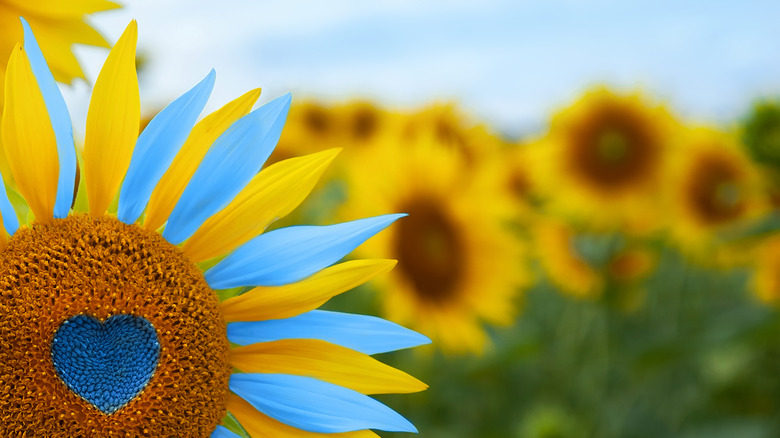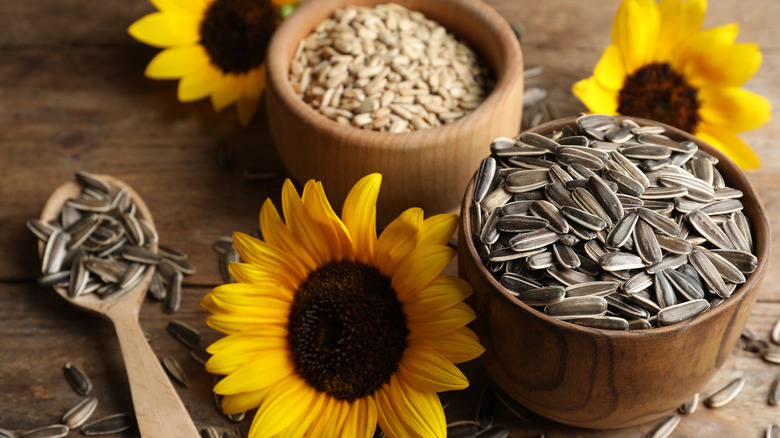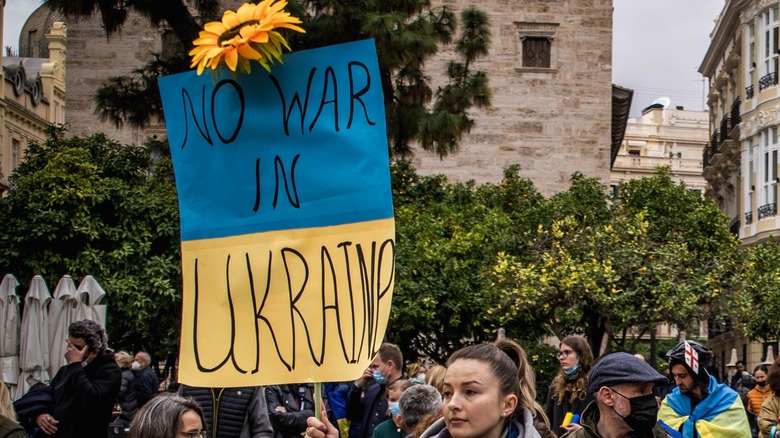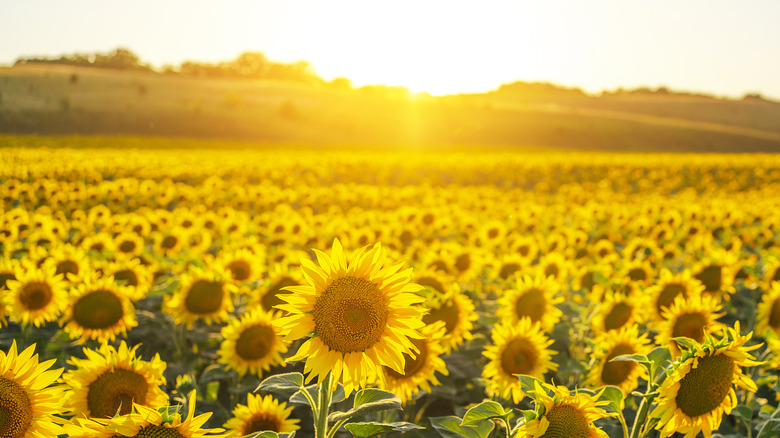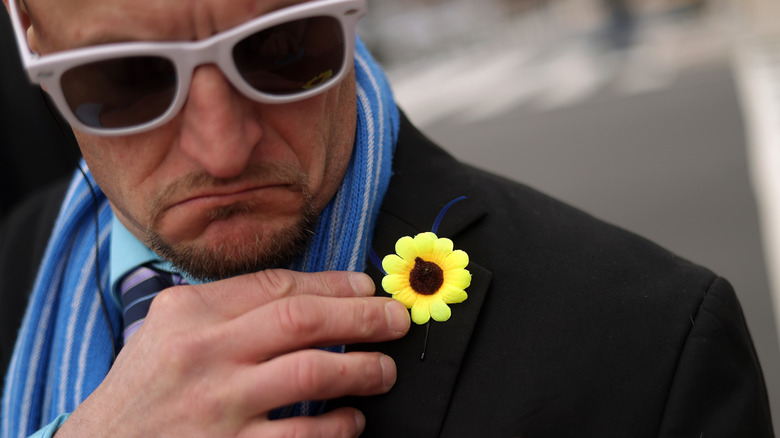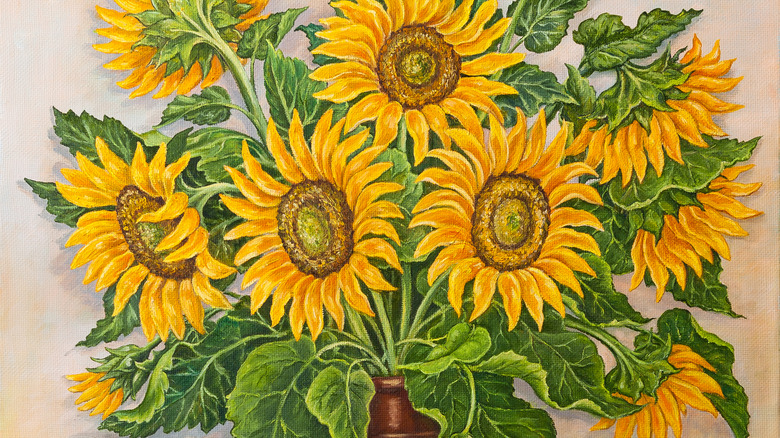Sunflowers: The Symbolism Behind Ukraine's National Flower Explained
It was the condemnation heard around the world. In a candid video, a Ukrainian woman confronted Russian soldiers on the street in Henychesk on February 24, 2022, the first day of the Russian invasion of Ukraine. Telling the men they were occupiers unwelcome in her country, she urged them to put sunflower seeds in their pockets. "Take these seeds so sunflowers grow when you die here," she told them, according to a translation by BBC News (via Twitter).
The original post by Ukrainian World was shared widely on social media and viewed over eight million times, and the video introduced a new symbol onto the world stage: the sunflower. It is the national flower of Ukraine, and historically a symbol of peace. According to Time, the sunflowers and images of sunflowers that have begun to pop up everywhere, from social media profiles to Texas fields to billboards on Illinois roadsides, have come to symbolize support for Ukraine and resistance to the Russian invasion.
Ukraine's national flower is culturally and financially important
The Ukrainian word is sunyashniki. Beloved by Ukrainians and grown in large quantities throughout the central part of the country, sunflowers have both cultural and practical value. According to Time, sunflowers are a useful crop. Sunflower oil is a worldwide staple, and sunflower seeds are a popular snack. Ukraine and Russia produce around 80% of the world's sunflower oil, according to Reuters.
Because sunflowers are so prolific in Ukraine, particularly in the warm "Black Earth" regions where they grow particularly well in the rich soil, the image of fields full of sunflowers has come to represent the country. Sunflowers are phototropic, meaning the flower heads and upper leaves follow the sun across the sky, facing east in the morning and west in the evening. According to the cultural and travel website MIR, in Ukrainian folk history, the flower represents the sun. In pre-Christian days, the sun was worshiped by Slavic people.
The sunflower represents peace
After the Cold War ended in 1991, Ukraine was left with stockpiles of nuclear weapons. According to Time, the weapons amounted to the third-largest nuclear arsenal in the world. The country sought to get rid of its weapons, signing the United Nations Treaty on the Non-Proliferation of Nuclear Weapons in 1993. Ukrainian, Russian, and U.S. defense ministers planted sunflowers at a 1996 ceremony at a Ukraine missile base to celebrate Ukraine's denuclearization, according to Time.
Even though Russia and Ukraine have had conflicts since, including Russia's invasion of Ukraine that began in February 2022, Time points out that the post-Cold War symbolism of peace has not changed, and that the sunflower now represents hope for peace in the future. This view is backed up by the sunflower's appearance on anti-war protest signs. The imagery has also been embraced by the American nonprofit organization "Sunflower of Peace," which has been raising money to provide medical supplies for Ukrainians since 2015, dating back to days of the Russian invasion of the Donbas region of Ukraine.
A history of the sunflower
Despite being such an important part of Ukraine's landscape and economy, sunflowers are not native to the country. In fact, they're not native to Europe at all. Sunflowers are from North America, according to the Alternative Field Crops Manual, thought to be domesticated around 3000 years ago by American Indian tribes. From there, the crop spread north and south from Canada to Mexico.
Seeds were imported to Europe, where the flower was considered a curiosity until the people of Ukraine and western Russia adopted the plant as their own and began cultivating it in earnest. According to the cultural and travel website MIR, sunflowers became popular there for religious reasons. The Orthodox Church forbid the use of butter or lard during the season of Lent, traditionally a time of sacrifice. Sunflower oil, made from a newly-introduced plant, was not specifically forbidden. Therefore by 1800, Ukraine and western Russia had fields upon fields of sunflowers to provide homegrown oil for Lent.
Sunflowers represent solidarity with Ukraine
Ever since the day the Ukrainian woman told the Russian soldier to fill his pockets with sunflower seeds, images of sunflowers have been popping up worldwide and on the internet, to show support for the people of Ukraine. First Lady Jill Biden wore a dress with a sunflower on the sleeve to the State of the Union address on March 1, according to Time.
Sunflowers have been displayed by anti-war protesters in Mexico City, Caracas, and other locations throughout the world, including Russia, where protesting the war is illegal and has led to thousands of arrests, according to Yahoo! News. Sunflower billboards in Champaign, Illinois proclaim support for the people of Ukraine, as well as sunflower rock paintings in Vancouver, British Columbia. Meanwhile, master gardener and columnist Lois Miklas from Lancaster, Pennsylvania shared her gardening tips for people wanting to grow their own sunflowers as spring approaches, and as people have already started to do in Lubbock, Texas.
Sunflowers in support
Not just a symbol of solidarity, the Ukrainian national flower is also being used to provide financial support to Ukrainians during the Russian invasion of the country. Artists in Texas and Ohio pledged the proceeds from their sunflower-themed artwork to humanitarian organizations helping in Ukraine. Funds from a sunflower-growing competition in Cornwall, England were slated to be used for medical supplies for Ukraine, according to Planet Radio UK, participants from all over the world, including New Zealand and Thailand, jumped at the chance to be part of the sunflower growing fundraising effort.
The Boston organization Sunflower of Peace is raising money to send backpacks full of medical supplies to Ukraine, where within just under a month since the Russian invasion an estimated 900 civilians had been killed, according to the UN (via National Public Radio). Sunflower of Peace founder Katya Malakhova told Morning in America in an interview that the backpacks are equipped with basic first-aid and medical supplies to stop bleeding and help people survive "in extreme conditions."
